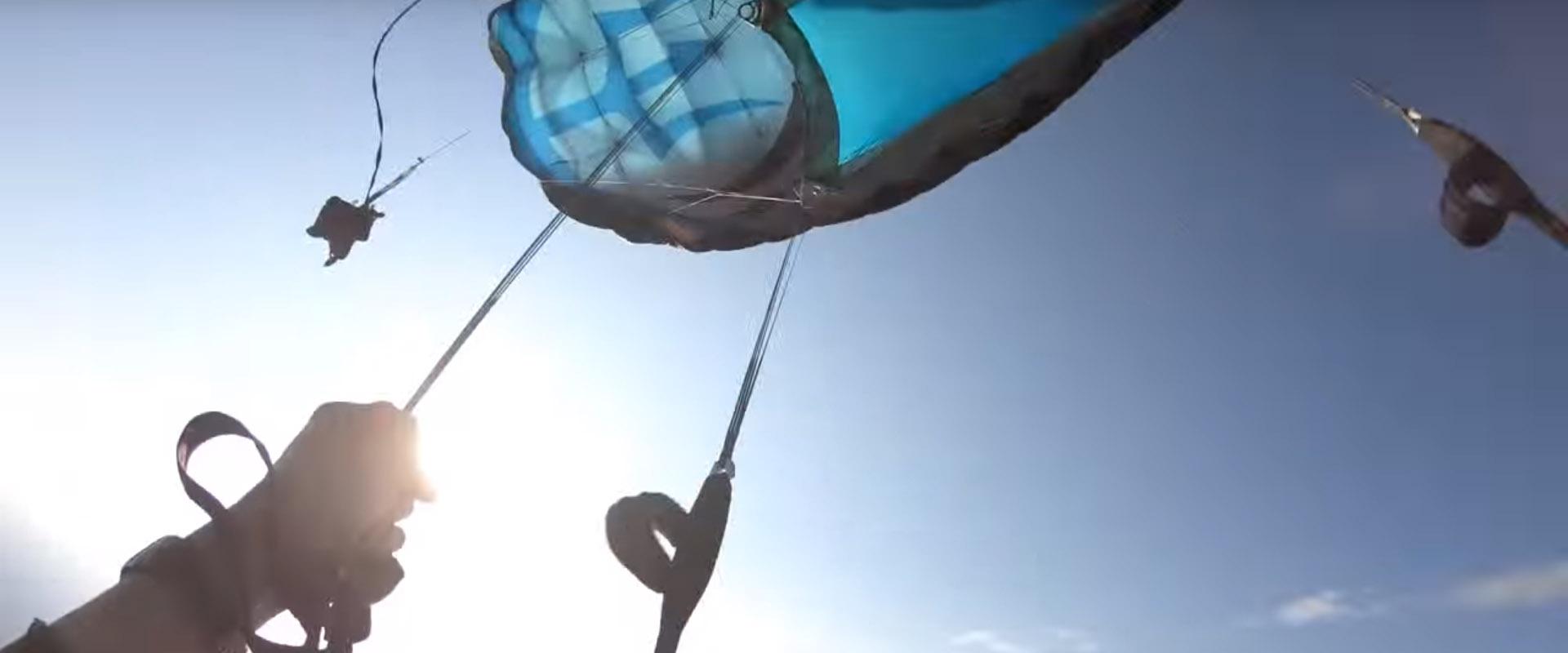Search the Community
Showing results for tags 'malfunctions'.
Found 3 results
-
I've been searching hard for an answer to this question and I'm just not able to find it. It seems to me based on all the various cutaway videos I've watched (very scientific, I know) that diving line twists almost never happen on reserve canopies. Can anyone give me the technical explanation for why this is the case? Is it something to do with the aspect ratio or trim of reserve canopies? Should this knowledge inform anything about I fly reserve canopies (ex. if trim is different)? Thanks in advance!
- 6 replies
-
- 1
-

-
- reserve
- line twist
-
See more
Tagged with:
-
This should be a relatively simple question, right? After all we learn them before we even go for our first skydive. Some people find it easy and some very difficult to deal with Emergency situations. So difficult that they couldn’t. It all depends how procedures are thought and consequently perceived. Motivations set goals and goals define perception, therefore instructors, manufacturers and riggers might give you slightly different versions on what would work best. Who decides? Education is the key, but only the right education! However, different opinions should be seriously considered as things change. This is very important as we have a strong tendency to reject ideas that fail to fit our preconceptions, labeling those ideas as unworthy of consideration— nonsense, irrelevant, weird, or mistaken “Of the 308 fatalities that were reported between 1993-2001, 264 (86%) were categorized as Human Error, indicating that human error was deemed to be the principal causal factor in the mishaps”, this study was done in the USA. So 264 people executing emergency procedures during this period made a fatal mistake. The same study concluded that- “Within skydiving training and education programs, specific attention should be given to human error, and training should be deliberately aimed at reducing human error mishaps.” This was concluded 20 years ago. What do you think has been done with relation to this? Not much, and in regards to reducing human error things have gotten even more complicated. In order to execute the correct emergency procedures, we need to identify the malfunction correctly and perform the correct action from all the available options. Here’s an example of one way to teach them: This is just an example. Looks good and it’s in color too, well presented and not that difficult to understand. There are many different types of these around. Are they the real deal? They should be, if they are around. And are they what the education needs? This type diagrams are consequence of the typical industrial type of education. The idea with the diagrams is that you learn it and when you need to respond to a malfunction situation- just execute the actions! That’s how computers work. Fast and accurate. But that’s not what happens in our heads. We are organic creatures. Skydiving is a high pace activity and we don’t have time to freeze, bring out the diagram with situations from the library, pick the right one and execute it. According to Adler (1991) and Schramm-Nielsen (2001), the decision-making process is comprised of specific stages including the recognition of the problem, search of information, alternatives, assessment of alternatives, selection of an alternative, implementation, control and feedback. Stress can also have an impact on each stage of the decision-making process (Moschis, 2007). Janis and Mann (1977) conclude that perceived stress in the decision-making process is a major cause of bad decisions and errors. And this is understandable- if we don’t know or understand what’s going on- the brain puts us in the pray response- freeze, fight, flight. Consequently, the following issues arise from the diagram way to learn emergency procedures- our nervous systems are not fast enough and humans are not “Stimuli response machine” when skydiving, nor while acting under any pressure or stress. This “Stimuli response machine” theory of human behavior was from the middle of the last century and it says that when you are presented with a problem, you consider it, make a decision and act. However, this mechanism is true and works ONLY when everything that happens goes to plan, we have time, we are not under pressure and have enough time to think. This rarely happens in real life, let alone when dealing with emergencies in skydiving. More importantly, diagrams and words are not how we think in skydiving and in general. What? What am I talking about? A new study led by Elinor Amit, an affiliate of the Psychology Department, shows that people create visual images to accompany their inner speech even when they are prompted to use verbal thinking, suggesting that visual thinking is deeply ingrained in the human brain while speech is a relatively recent evolutionary development. “This suggests that we can’t really go beyond the here and now and think in abstract ways about other people, places, or times,” Amit said. “This is the way our brains are wired, and there may be an evolutionary reason for this [because] we haven’t always been verbalizers. For a long time, we understood our world visually, so maybe language is an add-on. “That has important implications because if we are truly grounded in the here and now, what does that mean about how we develop public policy?” she added. “Do we need to help people overcome their bias to focusing on the here and now? This is something we may need to be aware of.” This is relevant to skydiving as when we think about skydiving we imagine pictures, frames, short clips. Human life and behavior is organized around our vision. This is another fact that separates us from animals as they have their life organized around smell. This is very important as it gives us the ability to build images in our heads and run simulations. But this is only possible if the training goes past the diagrams and involves video or photographs. Hey, it’s not really possible to see what’s exactly happening after you throw your pilot chute so we feel and build pictures in our head of the developing opening sequence. If our brain detects any mismatch with what’s supposed to happen- we are alerted to get ready. RAS is activated. Visualization is widely used in skydiving. So why did we stop using it for emergency procedures training? I know people that haven’t seen any emergency procedures visual aids since they finished their AFF course 10 years ago. Even worse, it’s actually hard to find updated video of emergency procedures done right in real situation. If things do not go as planned, the emotional system- the ancient brain takes over and acts. The systems that are activated in the stress situations have been studied in depth. More details are to be in different publication but one good example is the RAS- reticulate activating system, located mainly in the hippocampus. It keeps track of everything that doesn’t go to plan so we can react. This is the system that wakes you up at night if something wrong is happening- loud noise, anomaly in the environment, etc. The same system helps you drive your car when you are brain wondering and think about something else, whatever it is. It will alert you and help make a decision when the traffic light gets red so you can stop in response. What actually happens when things go wrong is – the hippocampus modulates the process there, primes the amygdala in case things go really wrong and it primes the hypothalamus, the part of our brain responsible for exploration /we need to find a solution/. The result is you are ready! The question is how worried should you be? And that depends on how ready you are for the emergency. The “Stimuli response machine” emergency procedures diagrams have some other inbuilt problems. One is that not all situations that happen are described, so they don’t give you a course of action for them. These should be resolved with the help of autonomous and divergent thinking. In order to do that we need have the necessary information. In skydiving, the necessary information involves equipment education and how parachute systems work. Unfortunately, there’s practically no formal education incorporated for licensed skydivers in this area. In other words, licensed skydivers unless they are riggers, luck the resources they need to deal with some situations. This can lead to developing of negative emotions in skydivers. The chronic overwhelm caused by these negative emotions can also harm the hippocampus, which is crucial for learning: this is where short-term memories, like what we've just heard or read, are converted to long- term memories, so we can recall them later. The hippocampus is extraordinarily rich in receptors for cortisol, so our capacity to learn is very vulnerable to stress. If we have constant stress in our lives, this flood of cortisol actually disconnects existing neural networks; we can have memory loss. We must learn to make our own interpretations rather than act on the purposes, beliefs, judgments, and feelings of others. So, what should we do? Practice and science show that the more prepared we are, the faster the solution and better the outcome is. How we perceive the situations in skydiving has immense influence on the outcome and the perception depends on our knowledge and experience. The ability to generate and then select the appropriate course of action is based on the decision maker’s “reading” of the situation—in other words, their ability to assess the situation and predict how it will evolve over the next few seconds. If equipment knowledge and understanding the process is in play, then dealing with emergency situations is significantly simplified. “In general, for freefall emergencies they come down to- If your main canopy is out or there’s a reason to believe it can come out- jettison the main and deploy the reserve. If the main parachute is not coming out- deploy your reserve! All these should be done high enough.” Knowing your equipment and how it works also fits the biological reasons to perceive the emergency situations as challenge and not as threat and to get into the competence/ confidence loop which means -less stress. In other words- we perceive the emergency situation as challenge, not threat. The right education? Well, looks like we need to work on it! All the above is just scratching the surface on the subject. It doesn’t explain everything and nothing in our brain does one thing only. Also, there are other factors in making decisions under stress too. However, humans have the necessary response abilities to act in high stress situations. They have been developing in the evolution for more than 300 million years. These abilities are very effective and we use them daily in our lives, in sports and even in skydiving. All these should be deeply utilised in the skydive training, not ignored! Maybe it’s time the available knowledge to be implemented for updating the skydiving education. Skydivers’ safety depends on that! Kras
-
We recently posted an article showcasing some really sweet videos to get you amped to hit the sky. The reality however, is that not every jump goes as planned. Sometimes you find yourself victim to a bad pack job, bad technique or failed equipment. The collection of videos below are some of the malfunctions that made their way onto Youtube in the past year. Use these videos to learn from other's mistakes, look at how others reacted to their incidents and how it affected their outcome. While some malfunctions one can laugh about later, others should serve solely as a lesson to other jumpers. From the uploader: "On my first jump with my Strix i had a toggle fire and needed to cutaway! Not the best body position and pitched with some speed. This is the only way that my great SABRE 1 wingsuit canopy can get into a diving spin." From the uploader: "After an uneventful jump, on deployment one of the riser covers of the Wings rig did not release, leading the PD 90 to deploy unevenly and start violent spinning behind the neck of the jumper. He was about to cut away the wing and pull his reserve when the riser cover released. The jumper checked his altitude, reasoned he had altitude to keep working on it a bit longer and then untwisted. He landed back at the dropzone exhausted and shocked, then switched container manufacturer as soon as he could." From the uploader: "Bag lock is a b*tch, especially on a tandem skydive. This TI and passenger were in the saddle by 1650 feet." From the uploader: "A skydiver has some heavy line twists on opening, which he fights all the way down to his hard deck before cutting away and deploying his reserve parachute -- which also opens with heavy line twists. Yikes!" From the uploader: "Skydiver rides his reserve parachute safely to the ground after a canopy malfunction!" From the uploader: "A pilot chute in tow malfunction is never fun, especially when you try to manually deploy your main parachute and end up flipping onto your back with a mess of lines wrapping around your leg. That’s exactly what happened to this skydiver. He pulled his cutaway, deployed his reserve and crossed his fingers that the reserve would clear the ball of $#!t above his head." From the uploader: "This jumper deployed their main, saw a malfunction they could not recover from, and cutaway. Their three-rings separated but a line got caught and the main parachute remained connected to the container. While attempting to clear the line entanglement, it appears the jumper pulled on their RSL and extracted their reserve pin; giving them a two-out. The jumper flew the reserve and, twenty seconds before safely landing their reserve, the main finally released." From the uploader: "As they exited the plane this jumper’s deployment bag came out of their container and gave them a horseshoe malfunction. They realized their pilot chute was still in the BOC and deployed it in an attempt to remedy the situation. Unfortunately, the pilot chute failed to extract the main, resulting in a SECOND malfunction! This time the jumper was faced with a bag lock. They cutaway their main, regained stability and deployed their reserve." From the uploader: "After an uneventful wingsuit flight this jumper deployed his main and found himself with a line over that sent him spinning. Unable to fly the canopy, he cutaway and – after dealing with some line twists – landed without further incident." From the uploader: "This skydiver pulled at 4k feet to get comfortable under canopy again -- it was their first jump after a 4 month break from skydiving. Once they deployed, they checked their canopy and thought it was an end cell closure, but quickly realized that it was actually a line-over. They began pumping the risers to clear it and continued to do so until they reached their decision altitude. The jumper claims they were preparing to cut away when they did one last pump of the risers and cleared the line-over."
-
- malfunctions
- incidents
-
See more
Tagged with:




